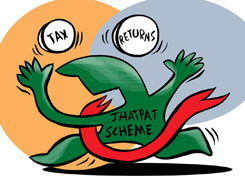Ramalingam Kalirajan |10881 Answers |Ask -Follow
Mutual Funds, Financial Planning Expert - Answered on Jun 24, 2025
He has an MBA in finance from the University of Madras and is a certified financial planner.
He is the director and chief financial planner at Holistic Investment, a Chennai-based firm that offers financial planning and wealth management advice.... more

Hello sir, I've 1.2Cr home loan under construction,I do 1L ppf and 50k NPS. I'm looking to use 80EE exemption-50K on loan interest HRA-3L in old regime 54F- no capital gain tax 80C-1.5L old regime Please help to choose the correct regime suitable for me. (Salary -25+)
Income and Deductions Overview
Your salary is Rs. 25+ lakhs per annum.
You contribute Rs. 1 lakh to PPF annually.
You also invest Rs. 50,000 in NPS yearly.
Home loan is Rs. 1.2 crore under construction.
You intend to use:
Section 80EE interest deduction up to Rs. 50,000.
HRA deduction of Rs. 3 lakh under old regime.
Section 54F to avoid capital gain tax.
Section 80C full limit of Rs. 1.5 lakh under old regime.
Understanding Both Tax Regimes
Let’s compare old and new tax regimes:
Old Regime
Higher tax slabs but allows full deductions.
You can claim PPF, NPS, home loan interest (section 80EE), HRA, 80C and 54F.
This lowers taxable income significantly.
New Regime
Lower tax slabs but fewer exemptions.
You lose deductions like HRA, 80C, 80EE, NPS (partial), 54F.
Only NPS under Section 80CCD(2) employer contribution is allowed.
Limited scope for reducing taxable income.
Deductions in Your Case
Let us evaluate critical deductions one by one:
1. Home Loan Interest (Section 80EE)
Eligible deduction up to Rs. 50,000 annually.
You are planning to claim this under old regime.
Under new regime, this deduction is not available.
2. HRA (House Rent Allowance)
You claim Rs. 3 lakh annually under old regime.
Not allowed under new regime.
3. Section 54F (Capital Gain Exemption)
If you sell any long-term asset and invest in home, you can save capital gains tax entirely.
Applicable under old regime only.
4. Section 80C Deduction
Total of Rs. 1.5 lakh including PPF, ELSS, life insurance premium, EPF etc.
You invest Rs. 1 lakh in PPF.
Remainder can be filled with approved instruments.
Old regime allows this full deduction, new regime does not.
5. 80CCD (NPS)
You invest Rs. 50,000 in NPS.
This comes under 80CCD(1B), allowed in old regime.
New regime only allows employer contribution (section 80CCD(2)), not employee’s.
Tax Impact Comparison
Your situation is well aligned for old regime benefits.
You have multiple deductions resulting in significant tax relief.
Under Old Regime You Can Claim:
Home loan interest under 80EE.
Full HRA up to Rs. 3 lakh.
Full 80C deduction of Rs. 1.5 lakh.
Section 54F if capital gains arise and are reinvested.
NPS under 80CCD(1B).
This makes your taxable income much lower.
Under New Regime:
You lose HRA, 80C, 80EE, 54F, NPS deductions.
Only basic exemption and standard deduction apply.
Tax will be higher due to loss of deductions.
You would pay far higher taxes under new regime than old.
Other Financial Planning Considerations
Let us now look beyond taxes to ensure your financial strength grows.
Emergency Fund
Maintain at least six months of household expenses.
Ideal corpus would be Rs. 3–5 lakh given your loan obligations.
Use liquid mutual funds or bank deposits.
Do not touch this for non-emergency.
Home Loan Strategy
Home loan under construction means you can claim interest only after possession for income tax.
But for tax planning, you can estimate future deductions.
After possession, allocate max interest under 80EE and HRA if you rent.
Continue PPF and NPS simultaneously to sustain deductions.
Retirement Corpus
You already invest in PPF and NPS.
That is a good retirement foundation.
You may also start SIP in actively managed equity mutual funds, via regular plans.
This helps grow retirement wealth beyond PPF/NPS.
Avoid index funds. They deliver only average returns. Actively managed funds adapt to market cycles.
Why Prefer Regular Plans via CFP Over Direct Funds
As your Certified Financial Planner, I ensure your portfolio is reviewed regularly.
Regular plans give guidance, rebalancing, and goal tracking.
Direct plans require you to handle rebalancing and timing alone.
Investors in direct plans often make emotional mistakes, like entering or exiting at wrong times.
With a CFP, you get discipline and professional support.
Scenario Examples
Let us see how things fit:
If You Choose Old Regime:
You get Rs. 1 lakh PPF, Rs. 50k NPS, Rs. 50k home loan interest, Rs. 3 lakh HRA, Rs. 1.5 lakh 80C, and 54F benefits.
Your taxable income drops significantly.
Likely lower total tax than new regime.
If You Choose New Regime:
Only standard deduction and no other exemptions.
You lose Rs. ~6–7 lakh worth of deductions.
Taxable income increases and tax liability rises.
Since your deductions exceed the increased tax difference, old regime is financially wiser.
Practical Steps for You
Choose Old Regime for this financial year.
Continue PPF and NPS contributions.
Claim home loan interest under 80EE.
Maintain HRA records to claim Rs. 3 lakh.
Plan 54F use when you sell assets and invest in property.
Track total investment under 80C and ensure full allocation.
After home possession, still claim interest under section 24 and HRA if renting.
Additional Growth and Protection Plans
Looking ahead, also consider these 360° aspects:
Insurance Needs
Ensure you have life cover and health insurance.
If no term plan exists, buy pure term plan for minimum Rs. 1 crore.
Have family floater health policy with Rs. 5–10 lakh cover.
Accident cover is inexpensive but useful.
Retirement SIPs
Add actively managed equity SIPs of Rs. 5k–10k if cash flow allows.
Keep old regime until major deductions are consistently used.
Revisit regime option every year.
Loan Repayment Strategy
After possession, consider increasing EMI or making lump sum prepayment when possible.
Reducing loan principal reduces total interest and speeds up debt-free status.
Emergency Corpus Build-Up
Set aside monthly savings for emergencies.
Ideal to reach at least Rs. 3 lakh.
Use for sudden job loss or medical crisis.
Final Insights
Old regime suits your situation best due to strong deduction profile.
Continue as you are with PPF, NPS, home loan interest and HRA claims.
Use 54F when capital gains arise and reinvest.
Stick to actively managed mutual funds via regular plans for growth.
Strengthen insurance, emergency corpus and loan repayment.
Review this annually and adjust as your situation changes.
Your planning is strong and thoughtful. With disciplined execution now, you can enhance tax savings and build long-term wealth. Should we work on balancing cash flow post-construction or selecting mutual fund categories next?
Best Regards,
K. Ramalingam, MBA, CFP,
Chief Financial Planner,
www.holisticinvestment.in
https://www.youtube.com/@HolisticInvestment
Section 80EE applies only if loan was sanctioned before March 31, 2017. If your home loan is newer, you cannot claim 80EE.
Section 54F is still valid in FY 2025–26 for capital gains from long-term assets other than residential property, if full net sale proceeds are invested in one residential property.
So:
80EE likely not applicable for recent loans.
54F is applicable, based on asset type and reinvestment.
Best Regards,
K. Ramalingam, MBA, CFP,
Chief Financial Planner,
www.holisticinvestment.in
https://www.youtube.com/@HolisticInvestment
You may like to see similar questions and answers below
Nikunj Saraf | Answer |Ask -Follow
Mutual Funds Expert - Answered on Feb 04, 2023
Mihir Tanna |1090 Answers |Ask -Follow
Tax Expert - Answered on Feb 23, 2023
Vivek Lala |323 Answers |Ask -Follow
Tax, MF Expert - Answered on Mar 20, 2023
Mihir Tanna |1090 Answers |Ask -Follow
Tax Expert - Answered on Feb 28, 2023
Mihir Tanna |1090 Answers |Ask -Follow
Tax Expert - Answered on Sep 16, 2023
Nayagam P P |10854 Answers |Ask -Follow
Career Counsellor - Answered on Dec 14, 2025
Radheshyam Zanwar |6744 Answers |Ask -Follow
MHT-CET, IIT-JEE, NEET-UG Expert - Answered on Dec 14, 2025
Radheshyam Zanwar |6744 Answers |Ask -Follow
MHT-CET, IIT-JEE, NEET-UG Expert - Answered on Dec 14, 2025
Dr Dipankar Dutta |1840 Answers |Ask -Follow
Tech Careers and Skill Development Expert - Answered on Dec 14, 2025
Dr Dipankar Dutta |1840 Answers |Ask -Follow
Tech Careers and Skill Development Expert - Answered on Dec 13, 2025
Dr Dipankar Dutta |1840 Answers |Ask -Follow
Tech Careers and Skill Development Expert - Answered on Dec 13, 2025
Mayank Chandel |2575 Answers |Ask -Follow
IIT-JEE, NEET-UG, SAT, CLAT, CA, CS Exam Expert - Answered on Dec 13, 2025
Radheshyam Zanwar |6744 Answers |Ask -Follow
MHT-CET, IIT-JEE, NEET-UG Expert - Answered on Dec 13, 2025
Mayank Chandel |2575 Answers |Ask -Follow
IIT-JEE, NEET-UG, SAT, CLAT, CA, CS Exam Expert - Answered on Dec 13, 2025
Mayank Chandel |2575 Answers |Ask -Follow
IIT-JEE, NEET-UG, SAT, CLAT, CA, CS Exam Expert - Answered on Dec 13, 2025
























